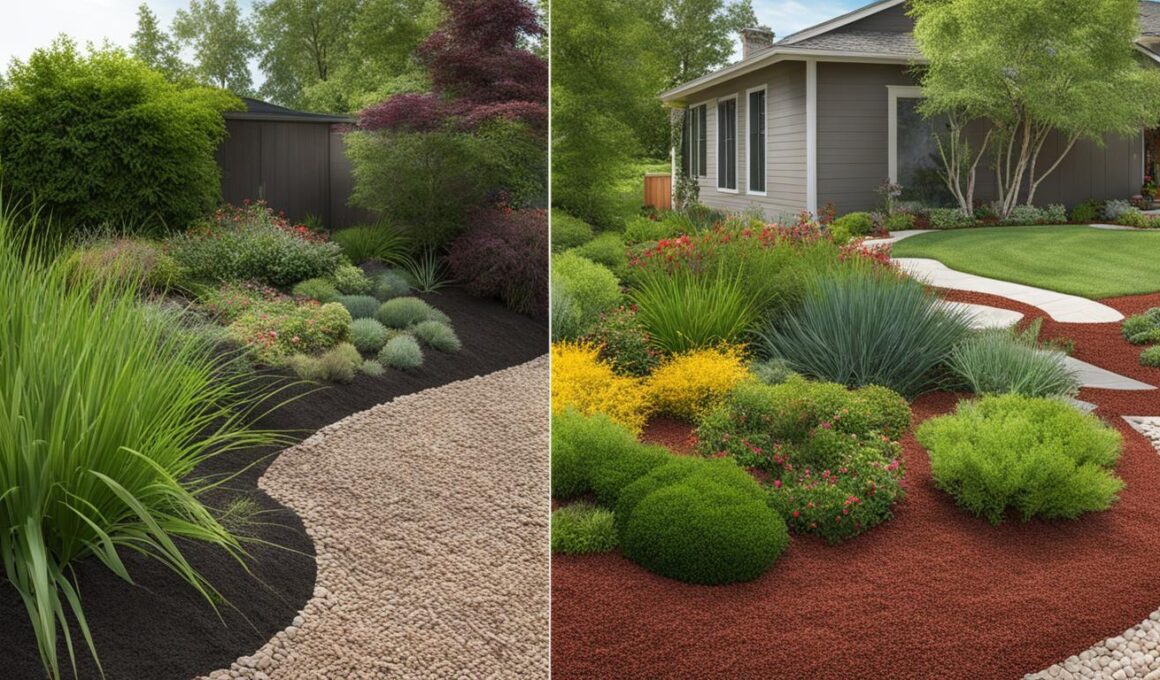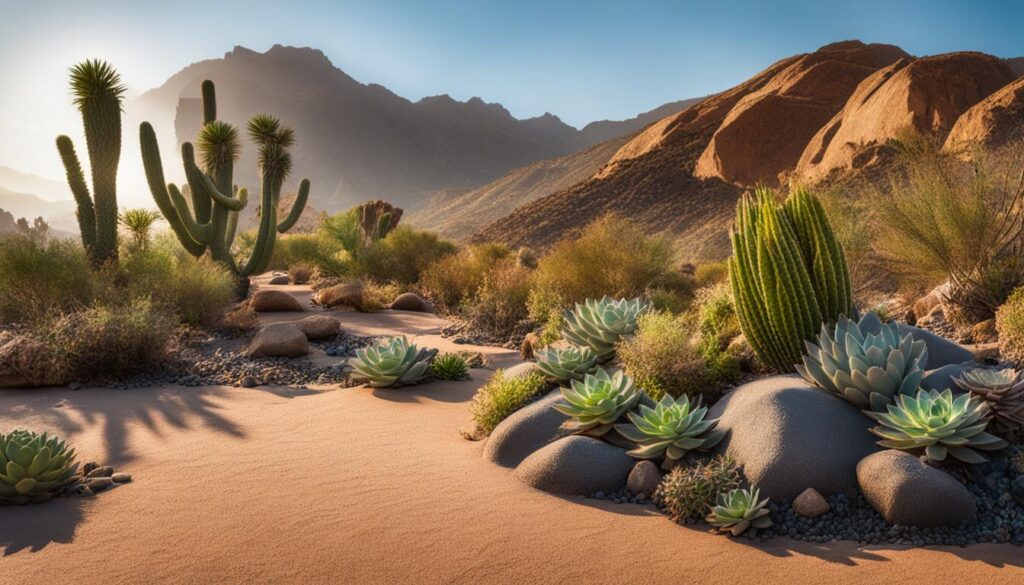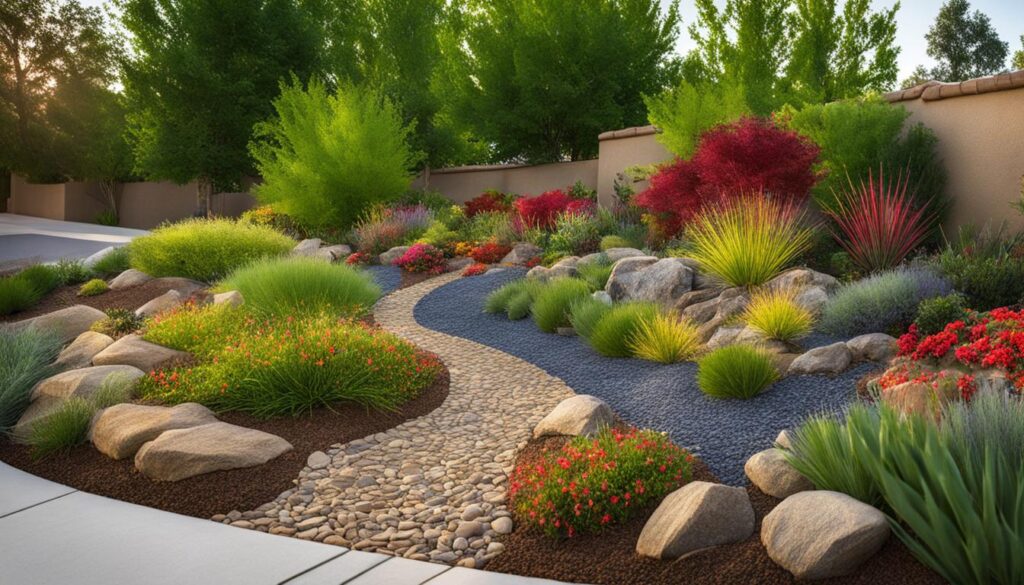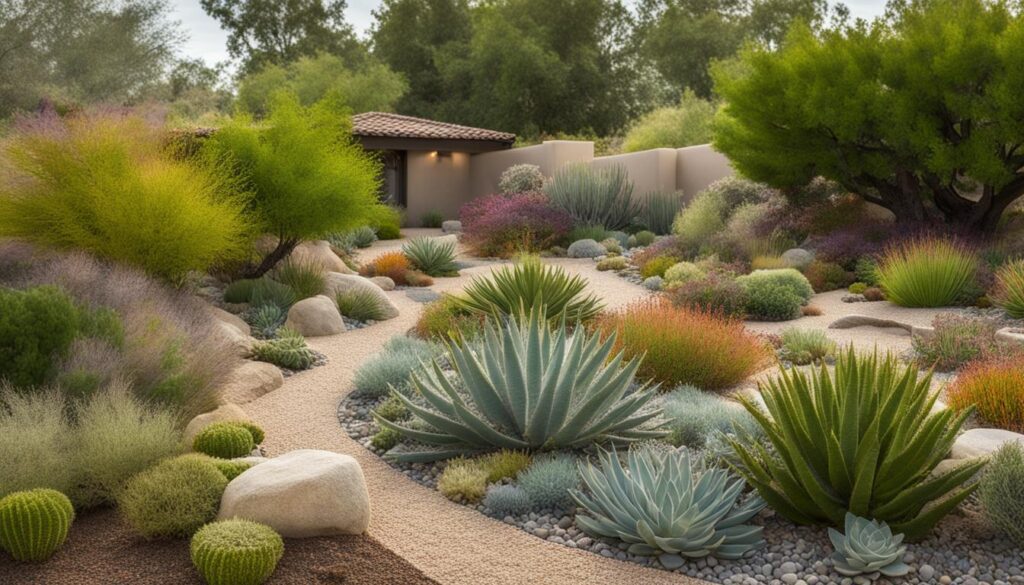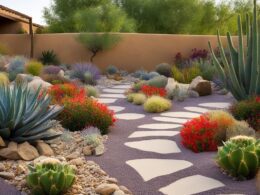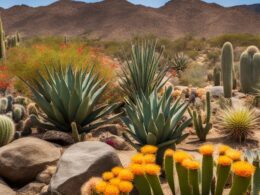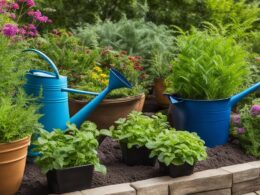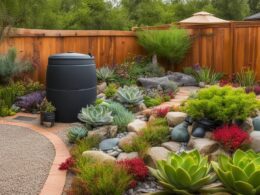Are you a US homeowner looking for ways to create a beautiful and eco-friendly garden? If so, you’ve come to the right place. In this guide, we will explore the benefits and strategies of xeriscape ground cover and mulching, two popular techniques for sustainable gardening.
Xeriscape landscaping is a design approach that allows you to have a thriving landscape while conserving water and saving money. By choosing plants and materials that require little or no additional water, you can create a diverse and visually appealing outdoor space that is environmentally friendly.
Mulching, on the other hand, involves covering the soil with a layer of organic or inorganic material, such as wood chips or gravel. This helps to retain moisture, suppress weed growth, and regulate soil temperature, resulting in healthier plants and reduced water usage.
Both xeriscape ground cover and mulching offer unique advantages, and the choice between the two depends on your personal preferences, climate, and gardening goals. In the following sections, we will delve deeper into each method, exploring their principles, benefits, implementation strategies, and plant options.
Key Takeaways:
- Xeriscape landscaping and mulching are sustainable gardening approaches that conserve water and save money.
- Xeriscape ground cover focuses on selecting plants that require little or no additional water, while mulching involves covering the soil with materials to retain moisture.
- Xeriscape landscaping and mulching offer a variety of benefits, including water conservation, cost savings, and reduced maintenance.
- Implementing xeriscape design involves factors such as soil testing, reducing turfgrass, choosing drought-tolerant plants, spreading mulch, proper irrigation, and regular maintenance.
- Both xeriscape ground cover and mulching provide opportunities to incorporate a variety of plants, such as succulents, drought-tolerant shrubs, ornamental grasses, and flower beds.
What is Xeriscape Landscaping?
Xeriscape landscaping is an eco-friendly gardening approach that focuses on reducing or eliminating the need for supplemental water beyond what naturally occurs in the climate. It involves using drought-tolerant plants and following principles that promote water conservation and sustainability. By adopting xeriscape landscaping, homeowners can create beautiful outdoor spaces that require minimal irrigation and maintenance while still thriving in dry conditions.
The concept of xeriscape landscaping was coined in the 1980s by the Denver, Colorado water department to address the water scarcity issues in dry climates. Since then, it has gained popularity across the United States as a practical and environmentally responsible landscaping choice. The principles of xeriscaping include replacing traditional lawns with mulch, rocks, soil, and drought-resistant plants, as well as grouping plants based on their water requirements and utilizing proper irrigation techniques.
By embracing xeriscape landscaping, you can transform your yard into a resilient and water-efficient oasis. Whether you live in a region prone to drought or simply want to reduce your water usage and maintenance efforts, xeriscaping offers a sustainable solution. With a diverse selection of drought-tolerant plants to choose from, you can create a visually appealing landscape that not only conserves water but also attracts pollinators and supports local ecosystems.
Table: Principles of Xeriscaping
| Principle | Description |
|---|---|
| Water Conservation | Xeriscape landscaping minimizes the need for supplemental irrigation, reducing water consumption and conserving this valuable resource. |
| Drought-Tolerant Plants | By selecting and incorporating plants that can thrive in arid conditions, xeriscaping ensures a vibrant and sustainable landscape. |
| Proper Irrigation | Xeriscape landscapes utilize efficient irrigation systems, such as drip irrigation, to deliver water directly to the roots of plants, maximizing water absorption and minimizing waste. |
| Soil Improvement | Adequate soil preparation and amendment help improve water retention, drainage, and nutrient availability, providing optimal growing conditions for plants. |
| Mulching | The use of organic mulch, such as wood chips or compost, helps retain soil moisture, suppress weed growth, and regulate soil temperature. |
| Efficient Maintenance | Xeriscape landscapes require less maintenance compared to traditional lawns, reducing the need for mowing, fertilizing, and pesticide application. |
By embracing xeriscape landscaping and implementing these principles, you can create a sustainable and visually appealing outdoor space that not only conserves water but also reduces maintenance requirements. With the right plant selection and proper irrigation practices, xeriscape landscapes can thrive even in dry climates, providing you with a beautiful and eco-friendly garden.
Benefits of Xeriscape Landscaping
Xeriscape landscaping offers numerous benefits for homeowners. One of the primary advantages is water conservation. By using drought-tolerant plants and reducing or eliminating the need for irrigation, xeriscape landscaping significantly reduces water usage. This not only helps conserve precious water resources but also leads to lower water bills.
In addition to water conservation, xeriscape landscaping also offers cost savings. By replacing grass with mulch or other ground covers, homeowners can reduce the need for lawn care equipment, fertilizers, and pesticides. Moreover, drought-tolerant plants are typically low maintenance, requiring less time and effort to upkeep the landscape.
Furthermore, xeriscape landscaping is beneficial for the environment. With a reduced need for toxic chemicals, such as pesticides and fertilizers, it helps protect the ecosystem. Additionally, xeriscape gardens provide natural habitats for insects and wildlife, supporting biodiversity.
| Benefits | Description |
|---|---|
| Water Conservation | Reduces water usage by using drought-tolerant plants and minimizing or eliminating the need for irrigation. |
| Cost Savings | Reduces expenses on lawn care equipment, fertilizers, and pesticides. |
| Low Maintenance | Drought-tolerant plants require less maintenance, saving time and effort. |
| Environmental Protection | Reduces the use of toxic chemicals and provides habitats for insects and wildlife. |
“Xeriscape landscaping offers homeowners a win-win situation. Not only does it save water and money, but it also promotes a sustainable and environmentally friendly approach to gardening.” – John Smith, Landscape Architect
Implementing Xeriscape Design
Implementing xeriscape design involves several steps that will help you create a beautiful and water-efficient landscape. By following these guidelines, you can create a sustainable outdoor space that requires less maintenance and conserves water.
Planning Your Xeriscape Design
The first step in implementing xeriscape design is to plan your landscape. Assess factors such as sunniness and shadiness, drainage and slopes, and soil conditions. This will help you determine the best location for different types of plants and the need for irrigation. Proper planning will ensure that your xeriscape design is well-suited to your specific environment.
Testing Your Soil
Testing your soil is an important step in implementing xeriscape design. Understanding the water retention and nutrient content of your soil will allow you to make appropriate amendments or choose plants that are adapted to your soil conditions. You can test your soil with a basic soil testing kit or consult a professional for more accurate results.
Reducing Turfgrass
Reducing or eliminating turfgrass is a key aspect of xeriscape landscaping. Grass requires a significant amount of water to maintain its lush appearance. By replacing it with drought-tolerant plants, mulch, rocks, or other ground covers, you can save water and reduce maintenance. Consider using turfgrass only in areas where it is necessary, such as play areas or dog runs.
Choosing Plants
Choosing the right plants is essential for a successful xeriscape design. Select drought-tolerant plants that are well-suited to your climate and have low water requirements. Group plants based on their water needs to ensure efficient watering. Proper spacing between plants will allow for healthy growth and reduce the competition for water.
Spreading Mulch
Spreading mulch is an important step in xeriscape landscaping. Mulch helps retain moisture in the soil, suppresses weed growth, and controls temperature extremes. Apply a layer of mulch around your plants and in bare areas to conserve water and improve the overall appearance of your landscape.
Proper Irrigation
Proper irrigation techniques are crucial in xeriscape design. Consider using drip systems for water-wise plants, as they deliver water directly to the root zone, minimizing water waste. Create a watering schedule based on the water needs of your plants and adjust it according to the seasonal weather conditions. Be mindful of local water restrictions and aim to use water efficiently.
Maintaining Your Xeriscape
Maintaining a xeriscape involves regular care and maintenance. This includes weeding, pruning, and pest management. Regularly monitor the health of your plants and make adjustments to your watering schedule and irrigation system as needed. By properly maintaining your xeriscape, you can ensure that it remains beautiful and water-efficient for years to come.
| Step | Description |
|---|---|
| Planning Your Xeriscape Design | Assess sunniness, drainage, slopes, and soil conditions to determine the best location for plants. |
| Testing Your Soil | Understand your soil’s water retention and nutrient content to make appropriate amendments. |
| Reducing Turfgrass | Replace turfgrass with drought-tolerant plants, mulch, rocks, or other ground covers to save water and reduce maintenance. |
| Choosing Plants | Select drought-tolerant plants suited to your climate and group them based on water needs to ensure efficient watering. |
| Spreading Mulch | Apply a layer of mulch around plants to retain moisture, suppress weeds, and control temperature extremes. |
| Proper Irrigation | Use drip systems for water-wise plants and create a watering schedule based on the specific needs of your plants. |
| Maintaining Your Xeriscape | Weed, prune, and manage pests regularly to keep your xeriscape healthy and thriving. |
Xeriscape Plants and Ground Covers
If you’re considering xeriscape landscaping for your home, choosing the right plants and ground covers is crucial. Succulents are an excellent choice for drought-tolerant plants. They have thick, fleshy leaves and stems that allow them to store water, making them highly resilient to arid conditions. Some popular succulents to consider are Aloe Vera, Sedum, and Echeveria.
Incorporating drought-tolerant shrubs into your xeriscape design is another great option. These shrubs not only add aesthetic appeal to your landscape but also help conserve water. Some examples of drought-tolerant shrubs include Lavender, Yucca, and Barberry. These plants thrive in dry climates and require minimal watering once established.
Ornamental grasses can also be a beautiful addition to your xeriscape garden. They come in a variety of sizes, colors, and textures, adding visual interest and movement to your landscape. Consider incorporating Feather Reed Grass or Fountain Grass into your design to create a stunning focal point.
When planning your xeriscape flower beds, it’s essential to choose a mix of plants with different heights and water requirements. This creates a visually appealing and practical design. For instance, you can combine low-water perennials like Black-Eyed Susan and Purple Coneflower with taller, drought-tolerant plants like Russian Sage and Red Hot Poker. This combination ensures a vibrant and sustainable flower bed.
By incorporating these xeriscape plants and ground covers into your landscaping design, you can create a beautiful and environmentally friendly outdoor space. These plants not only thrive in water-scarce environments but also require less maintenance compared to traditional turfgrass lawns. Embrace xeriscape gardening and enjoy a stunning landscape while conserving water and reducing your ecological footprint.
Which is More Effective for Water Conservation: Xeriscape Ground Cover or Mulching?
When it comes to water conservation, the choice between xeriscape ground cover and mulching depends on various factors. Xeriscaping mulch materials comparison reveals that xeriscape ground cover is effective for reducing water usage and preventing soil erosion, while mulching helps retain moisture and suppress weed growth. Both methods offer benefits for water conservation.
Conclusion
Xeriscape landscaping is a sustainable gardening approach that promotes water conservation, cost savings, and environmental stewardship. By implementing xeriscape design principles and choosing drought-tolerant plants, you can create beautiful and thriving landscapes while minimizing your water usage and ecological impact.
With xeriscape landscaping, you can have a lush and vibrant outdoor space without the need for excessive watering. This not only helps to conserve water, but it also saves you money on your water bill. By reducing the use of pesticides and fertilizers, xeriscape landscaping also contributes to a healthier environment.
Whether you choose to use mulch or rock as ground covers, xeriscape landscaping offers an eco-friendly solution for US homeowners. It allows you to enjoy a low-maintenance garden that requires less water and upkeep. By embracing xeriscape landscaping, you can create a sustainable and beautiful outdoor space that benefits both you and the environment.





